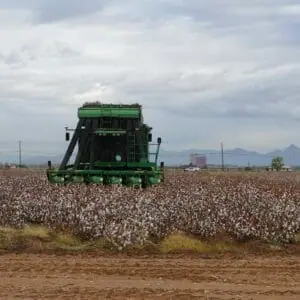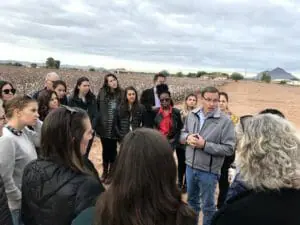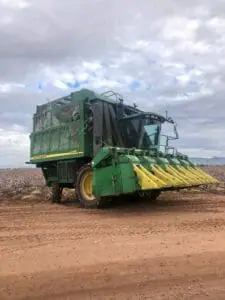This blog post was written by Arizona State University graduate student Katie Davis. In addition to studying Food Policy and Sustainability Leadership at ASU, Katie is tackling the issue of postharvest food waste as the senior manager of regulatory affairs for Apeel Sciences in Santa Barbara, CA.
Just a short drive outside Phoenix, in Mesa, Arizona, is the Hatley family farm. Now known as Associated Farms, Adam Hatley and his family have been farming this land since 1976, when Adam’s father first started cultivating the land here. They grow approximately 1,200 acres of cotton on land leased from the Salt River Pima-Maricopa Indian Community. While cotton is not the number one crop in Arizona and production has been declining in recent years, it is still incredibly important to the state’s economy.
According to the Arizona Farm Bureau, the cotton industry brings $350 million to $500 million dollars into Arizona every year. To get a deeper understanding of what it takes to grow cotton in this part of Arizona, Adam graciously invited us to come visit to learn more about their operation, how technology is changing cotton production, and how they are diversifying to manage risk.
As a large acre conventional cotton farmer, we were curious how Adam is leveraging technology in his operations. He explained that the most significant shift he has seen in the industry is the introduction of biotechnology to agriculture. With cotton plants that have been developed to resist certain pest pressure, for example pink boll worm, Adam explained that he is now able to use fewer pesticides, reducing his operational costs and improving the sustainability of his operations. For example, prior to the availability of genetically-engineered cotton, they were spraying insecticide on their fields every 14 days. Additionally, these same plants have also been developed to withstand the use of herbicides, allowing growers like Adam to increase their efficiency by eliminating the need for manual labor to pull weeds throughout the growing season.
In this part of Arizona, the agriculture community is diverse, from large to small conventional and organic farms that are growing everything from cotton to citrus to lettuce. Within this region, the diversity in production methods is incredibly broad. While the majority of Associated Farms’ acres are devoted to conventional cotton, Adam explained that they are now bringing in other crops to diversify their operations, including alfalfa and organic leafy greens. To successfully farm both conventional and organic crops, the Hatleys work closely with their neighbors to ensure their farming practices allow them to coexist in harmony with those around them. Adam noted that communication with local stakeholders, including the Salt River Pima-Maricopa Indian Community, is key to their continued success.
We were lucky enough to visit the first week of December 2019, right in the middle of their seasonal harvest. While we were speaking with Adam, the mechanical cotton harvester was busy working the fields. As we were admiring the beauty of the farm and surrounding land, the harvester (pictured here) came up for a turn to go back down the row. Seeing up-close this agricultural innovation that has dramatically enhanced the efficiency of cotton production was a highlight for the group. The Hatleys farm is yielding about 1,300 pounds of cotton per acre — most of which will be sent overseas to parts of Asia and the Middle East. Adam showed us that the Arizona cotton industry is not only thriving, but is adapting to changing demands of the industry, while providing an important commodity for the global market. >
>On behalf of the entire ASU Food Policy and Sustainability Cohort, I would like to extend our sincere appreciation to Adam and his staff for giving us the opportunity to visit and learn more about Arizona cotton production.
Interested in learning more about the Food Policy and Sustainability Leadership Program at ASU? Check out its program page!


